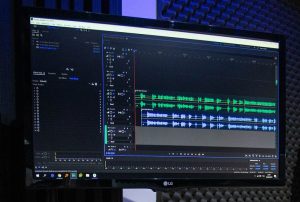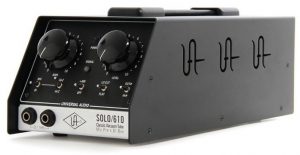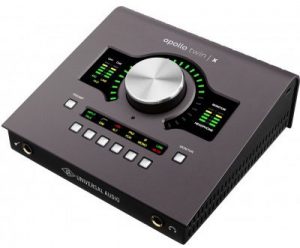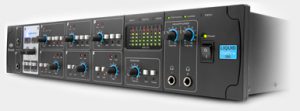Performing in the digital realm is a slight mindset shift from what’s been the norm. A great way to get in front of people and monetize your efforts at the same time is YouTube.
You’re going to need some equipment if you want to achieve good results. That’s not to say you can’t get away with a mediocre budget. But if you want to compete with the professionals you’re going to need to upgrade at one stage or another.
 The biggest concern as a guitar player is getting your audio signal into the DAW (digital audio workstation). Of course there’s other external recording gear that can work for these purposes, but the modern route involves the use of a DAW like Pro Tools or Cubase.
The biggest concern as a guitar player is getting your audio signal into the DAW (digital audio workstation). Of course there’s other external recording gear that can work for these purposes, but the modern route involves the use of a DAW like Pro Tools or Cubase.
Conversion is a big factor in achieving great results. This is the process of converting an audio signal from analog to digital. It should be carried out using a high quality, 24-bit audio interface. Of course, there are a number of other factors at play such as dynamic range and the overall sound and feel of the unit(s).
The difference between an audio interface that costs a few hundred and one that costs a few thousand is significant. It’s best summarized by AudioTechnology’s review of Apogee’s latest audio interface, the Symphony: 
Imagine standing front and centre before a large, flat panel, hi-definition screen, watching a scene from a western flick with a cowboy-laden horse galloping full speed towards you. Behind the charging stallion a red cloud of dust rises like a fiery backdrop. As the horse nears you can see the expression on the rider’s face, the pistol in his belt, the crest on his Stetson. It’s an impressive sight, but you’re still looking at a screen, observing from a distance, impersonally.
Now imagine watching the same scene on a gigantic, floor-to-ceiling cinema screen that curves around, enveloping your peripheral vision. It’s like you’re standing right there in the red wilderness beholding the sight in person. As the horse approaches, you feel your muscles tighten. You physically flinch when it does an almighty jump over the camera.
There are usually impedance issues when connecting directly to an entry-level audio interface. A better alternative is to use an external processor such as a multi-effects pedal. In many cases, you can use a S/PDIF digital output to bypass the analog-to-digital conversion that takes place at the sound card.
Instead of converting from digital to analog, and then back to digital, it makes sense to skip this step altogether. The good news is that even some entry-level audio interfaces allow for a digital S/PDIF connection.
Consider the signal route for a typical analog configuration:
Guitar > Analog-to-digital conversion > Effects processor > Digital-to-analog conversion > Analog-to-digital conversion > Audio interface
One of the most popular guitar plugins is Native Instruments Guitar Rig. They recently released an alternative to this product called Electric Sunburst, which allows you to trigger electric guitar samples from MIDI or a keyboard. All the samples were recorded with Guitar Rig. In the manual, the signal chain was revealed:
SESSION GUITARIST – ELECTRIC SUNBURST, or ELECTRIC SUNBURST, as we will call it in
this manual, is a pattern-based guitar library designed for ease of use in songwriting and music production. Its samples originate from a carefully selected instance of the iconic single-cutaway, double humbucker electric guitar. The instrument was recorded through Universal Audio Solo 610 preamps, whose bold transient reproduction and tube saturation prepared the guitar for further effects processing with virtual amps, cabinets and effects. To enable you to freely combine the two pickups, the individual signals were routed through two separate outputs and recorded through two separate preamps. In addition, for greater sonic variability, a small membrane condenser microphone was mounted directly above the strings to capture the sound of the plectrum hitting the strings.
The instrument was recorded through Universal Audio Solo 610 preamps, whose bold transient reproduction and tube saturation prepared the guitar for further effects processing with virtual amps, cabinets and effects. To enable you to freely combine the two pickups, the individual signals were routed through two separate outputs and recorded through two separate preamps. In addition, for greater sonic variability, a small membrane condenser microphone was mounted directly above the strings to capture the sound of the plectrum hitting the strings.
The signals were then converted by the SPL Madison analog-to-digital converter, and fed into an RME MADIface XT via MADI. Thanks to the superior tonal balance of the instrument, it was not necessary to add further effects like EQ or compression. When playing the instrument through high quality guitar amp and cabinet emulations, the sound will be as true to the original as technically possible.
Consumer-Grade Interfaces
An entry-level audio interface usually matches the impedance of an XLR microphone connection. You can achieve good results by placing a mic in front of a speaker cabinet, or by using the line out (headphone jack) of a multi-effects processor.
Alternatively, you can bypass the analog-to-digital conversion process by using a digital S/PDIF connection. Your audio interface will need a 24-bit digital input that can sync with an external clock.
Professional-Grade Interfaces
 For best results, a professional-grade interface is worth the money. This includes interfaces like the Apogee Ensemble, Universal Audio Apollo series, and the RME MADIface XT used for tracking Electric Sunburst.
For best results, a professional-grade interface is worth the money. This includes interfaces like the Apogee Ensemble, Universal Audio Apollo series, and the RME MADIface XT used for tracking Electric Sunburst.
My recommendation is the Ensemble or Apollo as both contain an instrument input. The Apollo Twin X was specifically made for guitarists, however, the x6 is also a great choice.
Focusrite Liquid Saffire 56

The Liquid Saffire 56 has been discontinued for many years, however it presents a cheaper alternative to all options listed previously.
This interface can still be obtained used for as little as $150.
It features an instrument input that correctly matches the impedance of a guitar. It’s compatible with both Windows and Mac OS.
It will require a FireWire connection. For best results, you will need a FireWire card that includes the Texas Instruments chipset.
